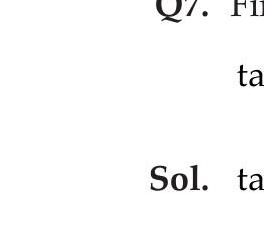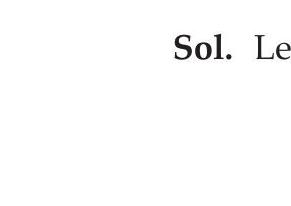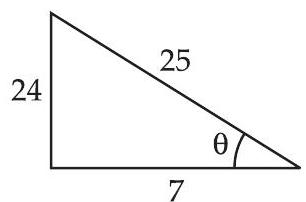Chapter 02 Inverse Trigonometric Functions
Short Answer Type Questions
1. Find the value of $\tan ^{-1}(\tan \frac{5 \pi}{6})+\cos ^{-1}(\cos \frac{13 \pi}{6})$.
Show Answer
Solution
We know that $\frac{5 \pi}{6} \notin(-\frac{\pi}{2}, \frac{\pi}{2})$ and $\frac{13 \pi}{6} \notin[0, \pi]$
$\therefore \tan ^{-1}(\tan \frac{5 \pi}{6})+\cos ^{-1}(\cos \frac{13 \pi}{6})$
$=\tan ^{-1}[\tan (\pi-\frac{\pi}{6})]+\cos ^{-1}[\cos (2 \pi+\frac{\pi}{6})]$
$=\tan ^{-1}[\tan (-\frac{\pi}{6})]+\cos ^{-1}(\cos \frac{\pi}{6})$
$=\tan ^{-1}(-\tan \frac{\pi}{6})+\cos ^{-1}(\cos \frac{\pi}{6})$
$=-\tan ^{-1}(\tan \frac{\pi}{6})+\cos ^{-1}(\cos \frac{\pi}{6}) \quad[\because \tan ^{-1}(-x)=-\tan ^{-1} x]$
$=-\frac{\pi}{6}+\frac{\pi}{6}=0$
Hence, $\tan ^{-1}(\tan \frac{5 \pi}{6})+\cos ^{-1}(\cos \frac{13 \pi}{6})=0$
2. Evaluate: $\cos [\cos ^{-1}(\frac{-\sqrt{3}}{2})+\frac{\pi}{6}]$
Show Answer
Solution
$\cos [\cos ^{-1}(\frac{-\sqrt{3}}{2})+\frac{\pi}{6}]$
$=\cos [\pi-\cos ^{-1} \frac{\sqrt{3}}{2}+\frac{\pi}{6}][\because \cos ^{-1}(-x)=\pi-\cos ^{-1} x]$
$=\cos [\pi-\frac{\pi /}{6}+\frac{\pi /}{6}]=\cos \pi=-1$
$ \text{ Hence, } \cos [\cos ^{-1}(\frac{-\sqrt{3}}{2})+\frac{\pi}{6}]=-1 \text{. } $
3. Prove that: $\cot (\frac{\pi}{4}-2 \cot ^{-1} 3)=7$.
Show Answer
Solution
L.H.S. $\cot (\frac{\pi}{4}-2 \cot ^{-1} 3)$
$=\cot [\tan ^{-1}(1)-2 \tan ^{-1} \frac{1}{3}] \quad[\because \cot ^{-1} x=\tan ^{-1} \frac{1}{x}]$
$=\cot [\tan ^{-1}(1)-\tan ^{-1} \frac{2 \times \frac{1}{3}}{1-(\frac{1}{3})^{2}}][\because 2 \tan ^{-1} x=\tan ^{-1} \frac{2 x}{1-x^{2}}]$
$=\cot [\tan ^{-1}(1)-\tan ^{-1} \frac{\frac{2}{3}}{\frac{8}{9}}]$
$=\cot [\tan ^{-1}(1)-\tan ^{-1} \frac{3}{4}]$
$=\cot [\tan ^{-1}(\frac{1-\frac{3}{4}}{1+1 \times \frac{3}{4}})]=\cot [\tan ^{-1}(\frac{\frac{1}{4}}{\frac{7}{4}})]$
$=\cot [\tan ^{-1} \frac{1}{7}] \quad[\because \tan ^{-1} \frac{1}{x}=\cot ^{-1} x]$
$=\cot [\cot ^{-1}(7)]=7$ R.H.S.
Hence proved.
4. Find the value of $\tan ^{-1}(\frac{-1}{\sqrt{3}})+\cot ^{-1}(\frac{1}{\sqrt{3}})+\tan ^{-1}[\sin (\frac{-\pi}{2})]$
Show Answer
Solution
$\tan ^{-1}(\frac{-1}{\sqrt{3}})+\cot ^{-1}(\frac{1}{\sqrt{3}})+\tan ^{-1}[\sin (\frac{-\pi}{2})]$ $=-\tan ^{-1}(\frac{1}{\sqrt{3}})+\tan ^{-1}(\sqrt{3})+\tan ^{-1}(-1)$
$ \begin{bmatrix} \because \tan ^{-1}(-x)=-\tan ^{-1} x \\ \tan ^{-1} x=\cot ^{-1}(\frac{1}{x}) \\ \sin (\frac{-\pi}{2})=-1 \end{bmatrix} $
$ =-\frac{\pi}{6}+\frac{\pi}{3}-\frac{\pi}{4}=\frac{-\pi}{12} \quad[\because \tan ^{-1}(-1)=\frac{-\pi}{4}] $
Hence, $\tan ^{-1}(\frac{-1}{\sqrt{3}})+\cot ^{-1}(\frac{1}{\sqrt{3}})+\tan ^{-1}[\sin (\frac{-\pi}{2})]=\frac{-\pi}{12}$
5. Find the value of $\tan ^{-1}(\tan \frac{2 \pi}{3})$
Show Answer
Solution
We know that $\frac{2 \pi}{3} \notin[\frac{-\pi}{2}, \frac{\pi}{2}]$
$ \begin{aligned} \therefore \tan ^{-1}(\tan \frac{2 \pi}{3}) & =\tan ^{-1}[\tan (\pi-\frac{\pi}{3})]=\tan ^{-1}(-\tan \frac{\pi}{3}) \\ & =-\tan ^{-1}(\tan \frac{\pi}{3})[\because \tan ^{-1}(-x)=-\tan ^{-1} x] \\ & =-\frac{\pi}{3} \in[-\frac{\pi}{2}, \frac{\pi}{2}] \end{aligned} $
Hence, $\tan ^{-1}(\tan \frac{2 \pi}{3})=\frac{-\pi}{3}$.
6. Show that: $2 \tan ^{-1}(-3)=\frac{-\pi}{2}+\tan ^{-1}(\frac{-4}{3})$
Show Answer
Solution
L.H.S. $2 \tan ^{-1}(-3)=-2 \tan ^{-1}(3)$
$ \begin{aligned} & =-\cos ^{-1}[\frac{1-(3)^{2}}{1+(3)^{2}}][\because 2 \tan ^{-1} x=\cos ^{-1}(\frac{1-x^{2}}{1+x^{2}})] \\ & =-\cos ^{-1}(\frac{1-9}{1+9})=-\cos ^{-1}(\frac{-8}{10}) \\ & =-\cos ^{-1}(\frac{-4}{5})=-[\pi-\cos ^{-1}(\frac{4}{5})]=-\pi+\cos ^{-1} \frac{4}{5} \\ & =-\pi+\tan ^{-1}(\frac{3}{4}) \quad[\because \cos ^{-1} \frac{4}{5}=\tan ^{-1} \frac{3}{4}] \end{aligned} $
$ \begin{matrix} =-\pi+\frac{\pi}{2}-\cot ^{-1}(\frac{3}{4}) & {[\tan ^{-1} x=\frac{\pi}{2}-\cot ^{-1} x]} \\ =\frac{-\pi}{2}-\cot ^{-1}(\frac{3}{4}) & {[\because \tan ^{-1} x=\cot ^{-1} \frac{1}{x}]} \\ =\frac{-\pi}{2}-\tan ^{-1}(\frac{4}{3}) & \\ =\frac{-\pi}{2}+\tan ^{-1}(-\frac{4}{3}) \text{ R.H.S. } & \end{matrix} $
Hence proved.
7. Find the real solutions of the equation
$ \tan ^{-1} \sqrt{x(x+1)}+\sin ^{-1} \sqrt{x^{2}+x+1}=\frac{\pi}{2} $
Show Answer
Solution
$\tan ^{-1} \sqrt{x(x+1)}+\sin ^{-1} \sqrt{x^{2}+x+1}=\frac{\pi}{2}$

$ \text{ Let } \quad \theta=\sin ^{-1} \sqrt{x^{2}+x+1} $
$\therefore \quad \sin \theta=\sqrt{x^{2}+x+1}$
$\Rightarrow \tan \theta=\frac{\sqrt{x^{2}+x+1}}{\sqrt{-x^{2}-x}} \Rightarrow \theta=\tan ^{-1}(\frac{\sqrt{x^{2}+x+1}}{\sqrt{-x^{2}-x}})$
$\Rightarrow \sin ^{-1} \sqrt{x^{2}+x+1}=\tan ^{-1}(\sqrt{\frac{x^{2}+x+1}{-x^{2}-x}})$
So, $\tan ^{-1} \sqrt{x(x+1)}+\tan ^{-1}(\sqrt{\frac{x^{2}+x+1}{-x^{2}-x}})=\frac{\pi}{2}$
$\Rightarrow \tan ^{-1}[\frac{\sqrt{x(x+1)}+\sqrt{\frac{x^{2}+x+1}{-x(x+1)}}}{1-\sqrt{x(x+1)} \times \sqrt{\frac{x^{2}+x+1}{-x(x+1)}}}]=\frac{\pi}{2}$
$\Rightarrow \tan ^{-1}[\frac{\frac{x(x+1)+\sqrt{-(x^{2}+x+1)}}{\sqrt{x(x+1)}}}{1-\sqrt{-(x^{2}+x+1)}}]=\frac{\pi}{2}$ $\Rightarrow \frac{x^{2}+x-\sqrt{-(x^{2}+x+1)}}{[1-\sqrt{-(x^{2}+x+1)}] \sqrt{x^{2}+x}}=\tan \frac{\pi}{2}=\frac{1}{0}$ $\Rightarrow[1-\sqrt{-(x^{2}+x+1)}] \sqrt{x^{2}+x}=0$ $\Rightarrow[1-\sqrt{-(x^{2}+x+1)}]=0$ or $\sqrt{x^{2}+x}=0$
Here, $\sqrt{-(x^{2}+x+1)} \notin R$
$\therefore \sqrt{x^{2}+x}=0$
$\Rightarrow \quad x^{2}+x=0 \Rightarrow x(x+1)=0$
$\Rightarrow \quad x=0$ or $x+1=0 \Rightarrow x=0$ or $x=-1$
Hence the real solutions are $x=0$ and $x=-1$.
Alternate Method
$ \begin{aligned} & \tan ^{-1} \sqrt{x(x+1)}+\sin ^{-1} \sqrt{x^{2}+x+1}=\frac{\pi}{2} \\ & \Rightarrow \tan ^{-1} \sqrt{x^{2}+x}=\frac{\pi}{2}-\sin ^{-1} \sqrt{x^{2}+x+1} \\ & \Rightarrow \tan ^{-1} \sqrt{x^{2}+x}=\cos ^{-1} \sqrt{x^{2}+x+1}[\because \sin ^{-1} x+\cos ^{-1} x=\frac{\pi}{2}] \\ & \Rightarrow \cos ^{-1}[\frac{1}{\sqrt{1+x^{2}+x}}]=\cos ^{-1} \sqrt{x^{2}+x+1} \\ & \Rightarrow \quad \frac{1}{\sqrt{x^{2}+x+1}}=\sqrt{x^{2}+x+1} \quad[\because \tan ^{-1} x=\cos ^{-1} \frac{1}{\sqrt{1+x^{2}}}] \\ & \Rightarrow \quad x^{2}+x+1=1 \quad \Rightarrow x^{2}+x=0 \\ & \Rightarrow \quad x(x+1)=0 \quad \Rightarrow x=0 \text{ or } x+1=0 \\ & \therefore \quad x=0, x=-1 \end{aligned} $
8. Find the value of the expression
$ \sin (2 \tan ^{-1} \frac{1}{3})+\cos (\tan ^{-1} 2 \sqrt{2}) $
Show Answer
Solution
$\sin (2 \tan ^{-1} \frac{1}{3})+\cos (\tan ^{-1} 2 \sqrt{2})$
$ \begin{aligned} & \Rightarrow \sin [\tan ^{-1}(\frac{2 \times \frac{1}{3}}{1-(\frac{1}{3})^{2}})]+\cos [\cos ^{-1} \frac{1}{\sqrt{1+(2 \sqrt{2})^{2}}}] \\ & {[\because \tan ^{-1} x=\cos ^{-1}(\frac{1}{\sqrt{1+x^{2}}})]} \\ & \Rightarrow \sin [\tan ^{-1}(\frac{\frac{2}{3}}{1-\frac{1}{9}})]+\cos [\cos ^{-1}(\frac{1}{3})] \\ & .\Rightarrow \sin [\tan ^{-1}(\frac{3}{4})]+\frac{1}{3} \Rightarrow \sin ^{-1}(\frac{3}{5})]+\frac{1}{3} \\ & \Rightarrow \frac{3}{5}+\frac{1}{3} \Rightarrow \frac{14}{15} \\ & \text{ Hence, } \sin (2 \tan ^{-1} \frac{1}{3})+\cos (\tan ^{-1} 2 \sqrt{2})=\frac{14}{15} . \end{aligned} $
9. If $2 \tan ^{-1}(\cos \theta)=\tan ^{-1}(2 cosec \theta)$, then show that $\theta=\frac{\pi}{4}$
Show Answer
Solution
$2 \tan ^{-1}(\cos \theta)=\tan ^{-1}(2 cosec \theta)$
$ \begin{aligned} & \Rightarrow \tan ^{-1}(\frac{2 \cos \theta}{1-\cos ^{2} \theta})=\tan ^{-1}(2 cosec \theta) \\ & \Rightarrow \quad[\because 2 \tan ^{-1} x=\tan ^{-1} \frac{2 x}{1-x^{2}}] \\ & \Rightarrow \quad \frac{2 \cos \theta}{1-\cos ^{2} \theta}=2 cosec \theta \Rightarrow \frac{2 \cos \theta}{\sin ^{2} \theta}=\frac{2}{\sin \theta} \\ & \Rightarrow \quad \cos \theta \sin \theta-\sin ^{2} \theta=0 \Rightarrow \sin \theta(\cos \theta-\sin \theta)=0 \\ & \Rightarrow \quad \sin \theta=0 \text{ or } \quad \cos \theta-\sin \theta=0 \\ & \Rightarrow \quad \sin \theta=0 \quad \text{ or } \quad 1-\tan \theta=0 \\ & \Rightarrow \quad \theta=0 \text{ or } \quad \tan \theta=1 \\ & \Rightarrow \quad \theta=0^{\circ} \text{ or } \quad \theta=\frac{\pi}{4} \text{ Hence proved. } \end{aligned} $
10. Show that: $\cos (2 \tan ^{-1} \frac{1}{7})=\sin (4 \tan ^{-1} \frac{1}{3})$
Show Answer
Solution
L.H.S. $\cos (2 \tan ^{-1} \frac{1}{7})$
$ \begin{aligned} & =\cos [\cos ^{-1} \frac{1-\frac{1}{49}}{1+\frac{1}{49}}] \quad[\because 2 \tan ^{-1} x=\cos ^{-1} \frac{1-x^{2}}{1+x^{2}}] \\ & =\cos [\cos ^{-1} \frac{48}{50}]=\cos [\cos ^{-1} \frac{24}{25}]=\frac{24}{25} \end{aligned} $
R.H.S. $\sin [4 \tan ^{-1} \frac{1}{3}]$
$ \begin{aligned} & =\sin [2 \tan ^{-1}(\frac{2 \times \frac{1}{3}}{1-\frac{1}{9}})][\because 2 \tan ^{-1} x=\tan ^{-1} \frac{2 x}{1-x^{2}}] \\ & =\sin [2 \tan ^{-1}(\frac{\frac{2}{3}}{\frac{3}{9}})]=\sin [2 \tan ^{-1} \frac{3}{4}] \\ & =\sin [\sin ^{-1} \frac{2 \times \frac{3}{4}}{1+\frac{9}{16}}][\because 2 \tan ^{-1} x=\sin ^{-1} \frac{2 x}{1+x^{2}}] \\ & =\sin [\sin ^{-1} \frac{24}{25}] \Rightarrow \frac{24}{25} \end{aligned} $
L.H.S. = R.H.S. Hence proved.
11. Solve the following equation: $\cos (\tan ^{-1} x)=\sin (\cot ^{-1} \frac{3}{4})$
Show Answer
Solution
Given that $\cos (\tan ^{-1} x)=\sin (\cot ^{-1} \frac{3}{4})$
$ \begin{aligned} \Rightarrow \cos [\cos ^{-1} \frac{1}{\sqrt{1+x^{2}}}]=\sin [\sin ^{-1} \frac{4}{5}] \\ { \begin{bmatrix} \because \tan ^{-1} x=\cos ^{-1}(\frac{1}{\sqrt{1+x^{2}}}) \\ \cot ^{-1} x=\sin ^{-1}(\frac{1}{\sqrt{1+x^{2}}}) \end{bmatrix} } \end{aligned} $
$ \Rightarrow \quad \frac{1}{\sqrt{1+x^{2}}}=\frac{4}{5} $
Squaring both sides we get,
$ \begin{aligned} & \frac{1}{1+x^{2}}=\frac{16}{25} \Rightarrow 1+x^{2}=\frac{25}{16} \\ & \Rightarrow \quad x^{2}=\frac{25}{16}-1=\frac{9}{16} \Rightarrow x= \pm \frac{3}{4} \\ & \text{ Hence, } \quad x=\frac{-3}{4}, \frac{3}{4} \text{. } \end{aligned} $
Long Answer Type Questions
12. Prove that: $\tan ^{-1}[\frac{\sqrt{1+x^{2}}+\sqrt{1-x^{2}}}{\sqrt{1+x^{2}}-\sqrt{1-x^{2}}}]=\frac{\pi}{4}+\frac{1}{2} \cos ^{-1} x^{2}$
Show Answer
Solution
L.H.S. $\tan ^{-1}[\frac{\sqrt{1+x^{2}}+\sqrt{1-x^{2}}}{\sqrt{1+x^{2}}-\sqrt{1-x^{2}}}]$
Put $x^{2}=\cos \theta \quad \therefore \theta=\cos ^{-1} x^{2}$
$\Rightarrow \tan ^{-1}[\frac{\sqrt{1+\cos \theta}+\sqrt{1-\cos \theta}}{\sqrt{1+\cos \theta}-\sqrt{1-\cos \theta}}]$
$\Rightarrow \tan ^{-1}[\frac{\sqrt{2 \cos ^{2} \theta / 2}+\sqrt{2 \sin ^{2} \theta / 2}}{\sqrt{2 \cos ^{2} \theta / 2}-\sqrt{2 \sin ^{2} \theta / 2}}] \begin{cases} \because 1+\cos \theta=2 \cos ^{2} \theta / 2 \\ 1-\cos \theta=2 \sin ^{2} \theta / 2 \end{cases} $
$\Rightarrow \tan ^{-1}[\frac{\cos \theta / 2+\sin \theta / 2}{\cos \theta / 2-\sin \theta / 2}]$
$\Rightarrow \tan ^{-1}[\frac{1+\tan \theta / 2}{1-\tan \theta / 2}] \quad$ [Dividing the Nr. and Den. by $\cos \theta / 2$ ]
$\Rightarrow \tan [\tan (\frac{\pi}{4} \quad \frac{\theta}{2})] \quad[\because \frac{1+\tan \theta}{1-\tan \theta}=\tan (\frac{\pi}{4}+\theta)]$
$\Rightarrow \frac{\pi}{4}+\frac{\theta}{2} \Rightarrow \frac{\pi}{4}+\frac{1}{2} \cos ^{-1} x^{2}$ R.H.S. $\quad$ [Putting $\theta=\cos ^{-1} x^{2}$ ]
Hence proved.
13. Find the simplified form of $\cos ^{-1}(\frac{3}{5} \cos x+\frac{4}{5} \sin x)$, where $x \in[\frac{-3 \pi}{4}, \frac{\pi}{4}]$
Show Answer
Solution
Given that $\cos ^{-1}(\frac{3}{5} \cos x+\frac{4}{5} \sin x)$
Put $\quad \frac{3}{5}=\cos y$
$\therefore \quad \sqrt{1-\cos ^{2} y}=\sin y \Rightarrow \sqrt{1-\frac{9}{25}}=\sin y \Rightarrow \frac{4}{5}=\sin y$
$\therefore \cos ^{-1}[\frac{3}{5} \cos x+\frac{4}{5} \sin x]=\cos ^{-1}[\cos y \cos x+\sin y \sin x]$
$=\cos ^{-1}[\cos (y-x)]=y-x$
$=\tan ^{-1} \frac{4}{3}-x$ $\frac{8}{7}+\sin ^{-1} \frac{3}{5}=\sin ^{-1} \frac{77}{85}$
14. Prove that: $\sin ^{-1} \frac{8}{17}+\sin ^{-}$
Show Answer
Solution
L.H.S. $\sin ^{-1} \frac{8}{17}+\sin ^{-1} \frac{3}{5}$
$ \begin{aligned} & \text{ Using } \sin ^{-1} x+\sin ^{-1} y=\sin ^{-1}[x \sqrt{1-y^{2}}+y \sqrt{1-x^{2}}] \\ & \begin{aligned} \sin ^{-1} \frac{8}{17}+ & \sin ^{-1} \frac{3}{5}=\sin ^{-1}[\frac{8}{17} \cdot \sqrt{1-(\frac{3}{5})^{2}}+\frac{3}{5} \cdot \sqrt{1-(\frac{8}{17})^{2}}] \\ & =\sin ^{-1}[\frac{8}{17} \cdot \sqrt{1-\frac{9}{25}}+\frac{3}{5} \cdot \sqrt{1-\frac{64}{289}}] \\ & =\sin ^{-1}[\frac{8}{17} \cdot \sqrt{\frac{16}{25}}+\frac{3}{5} \cdot \sqrt{\frac{225}{289}}] \\ & =\sin ^{-1}[\frac{8}{17} \cdot \frac{4}{5}+\frac{3}{5} \cdot \frac{15}{17}]=\sin ^{-1}[\frac{32}{85}+\frac{45}{85}] \\ & =\sin ^{-1} \frac{77}{85} \text{ R.H.S. Hence proved. } \end{aligned} \end{aligned} $
15. Show that: $\sin ^{-1} \frac{5}{13}+\cos ^{-1} \frac{3}{5}=\tan ^{-1} \frac{63}{16}$
Show Answer
Solution
Let $\sin ^{-1} \frac{5}{13}=x \quad \Rightarrow \quad \sin x=\frac{5}{13}$
$\Rightarrow \quad \tan x=\frac{5}{12}$
Let $\cos ^{-1} \frac{3}{5}=y \quad \Rightarrow \quad \cos y=\frac{3}{5}$
$\Rightarrow \quad \tan y=\frac{4}{3}$
Now $\quad \tan (x+y)=\frac{\tan x+\tan y}{1-\tan x \tan y}$

$\Rightarrow \quad \tan (x+y)=\frac{\frac{5}{12}+\frac{4}{3}}{1-\frac{5}{12} \times \frac{4}{3}}=\frac{\frac{15+48}{36}}{\frac{36-20}{36}}=\frac{63}{16}$
$\Rightarrow \quad x+y=\tan ^{-1} \frac{63}{16}$
$\therefore \sin ^{-1} \frac{5}{13}+\cos ^{-1} \frac{3}{5}=\tan ^{-1} \frac{63}{16}$ Hence proved.
16. Prove that: $\tan ^{-1} \frac{1}{4}+\tan ^{-1} \frac{2}{9}=\sin ^{-1} \frac{1}{\sqrt{5}}$
Show Answer
Solution
$\tan ^{-1} \frac{1}{4}+\tan ^{-1} \frac{2}{9}=\tan ^{-1}[\frac{\frac{1}{4}+\frac{2}{9}}{1-\frac{1}{4} \times \frac{2}{9}}]$
$[\because \tan ^{-1} x+\tan ^{-1} y=\tan ^{-1}(\frac{x+y}{1-x y})]$
$\Rightarrow \tan ^{-1}[\frac{\frac{9+8}{36}}{\frac{36-2}{36}}]=\tan ^{-1}[\frac{17}{34}]$
Let $\quad \tan ^{-1}[\frac{17}{34}]=x$
$\therefore \quad \tan x=\frac{17}{34}=\frac{1}{2}$

$ \begin{aligned} \sin x & =\frac{1}{\sqrt{5}} \\ \therefore \quad \tan ^{-1} \frac{1}{2} & =\sin ^{-1} \frac{1}{\sqrt{5}} \text{ R.H.S. } \end{aligned} $
Hence, $\tan ^{-1} \frac{1}{4}+\tan ^{-1} \frac{2}{9}=\sin ^{-1} \frac{1}{\sqrt{5}}$
17. Find the value of $4 \tan ^{-1} \frac{1}{5}-\tan ^{-1} \frac{1}{239}$
Show Answer
Solution
$4 \tan ^{-1} \frac{1}{5}-\tan ^{-1} \frac{1}{239}$
$\Rightarrow 2 \cdot(2 \tan ^{-1} \frac{1}{5})-\tan ^{-1} \frac{1}{239}$
$\Rightarrow 2[\tan ^{-1} \frac{2 \times \frac{1}{5}}{1-\frac{1}{25}}]-\tan ^{-1} \frac{1}{239} \quad[2 \tan ^{-1} x=\tan ^{-1} \frac{2 x}{1-x^{2}}]$
$\Rightarrow 2 \tan ^{-1} \frac{5}{12}-\tan ^{-1} \frac{1}{239} \Rightarrow \tan ^{-1}(\frac{2 \times \frac{5}{12}}{1-\frac{25}{144}})-\tan ^{-1}(\frac{1}{239})$
$\Rightarrow \tan ^{-1}(\frac{120}{119})-\tan ^{-1}(\frac{1}{239})$
$\Rightarrow \tan ^{-1}[\frac{\frac{120}{119}-\frac{1}{239}}{1+\frac{120}{119} \times \frac{1}{239}}][\because \tan ^{-1} x-\tan ^{-1} y=\tan ^{-1} \frac{x-y}{1+x y}]$
$\Rightarrow \tan ^{-1}[\frac{120 \times 239-119}{119 \times 239+120}] \Rightarrow \tan ^{-1}[\frac{28680-119}{28441+120}]$
$\Rightarrow \tan ^{-1}[\frac{28561}{28561}]=\tan ^{-1}(1)=\frac{\pi}{4}$
18. Show that $\tan (\frac{1}{2} \sin ^{-1} \frac{3}{4})=\frac{4-\sqrt{7}}{3}$ and justify why the other value $\frac{4+\sqrt{7}}{3}$ is ignored?
Show Answer
Solution
To prove that $\tan (\frac{1}{2} \sin ^{-1} \frac{3}{4})=\frac{4-\sqrt{7}}{3}$ L.H.S. Let $\frac{1}{2} \sin ^{-1} \frac{3}{4}=\tan ^{-1} \theta$ $[\therefore \tan (\tan ^{-1} \theta)=\theta]$
$ \begin{aligned} & \Rightarrow \quad \sin ^{-1} \frac{3}{4}=2 \tan ^{-1} \theta \Rightarrow \sin ^{-1} \frac{3}{4}=\sin ^{-1}(\frac{2 \theta}{1+\theta^{2}}) \\ & {[\because 2 \tan ^{-1} x=\sin ^{-1} \frac{2 x}{1+x^{2}}]} \\ & \Rightarrow \quad \frac{2 \theta}{1+\theta^{2}}=\frac{3}{4} \Rightarrow 3+3 \theta^{2}=8 \theta \\ & \Rightarrow \quad 3 \theta^{2}-8 \theta+3=0 \\ & \Rightarrow \quad \theta=\frac{-(-8) \pm \sqrt{(-8)^{2}-4 \times 3 \times 3}}{2 \times 3} \\ & =\frac{8 \pm \sqrt{64-36}}{6}=\frac{8 \pm \sqrt{28}}{6}=\frac{8 \pm 2 \sqrt{7}}{6}=\frac{2(4 \pm \sqrt{7})}{6} \\ & \Rightarrow \quad \theta=\frac{4 \pm \sqrt{7}}{3} \\ & \therefore \quad \theta=\frac{4+\sqrt{7}}{3} \text{ or } \frac{4-\sqrt{7}}{3} \\ & \theta=\frac{4+\sqrt{7}}{3} \text{ is ignored. } \\ & \text{ Because } \frac{-\pi}{2} \leq \sin ^{-1} \frac{3}{4} \leq \frac{\pi}{2} \\ & \Rightarrow \frac{-\pi}{4} \leq \frac{1}{2} \sin ^{-1} \frac{3}{4} \leq \frac{\pi}{4} \\ & \Rightarrow \tan (\frac{-\pi}{4}) \leq \tan (\frac{1}{2} \sin ^{-1} \frac{3}{4}) \leq \tan (\frac{\pi}{4}) \\ & \Rightarrow-1 \leq \tan (\frac{1}{2} \sin ^{-1} \frac{3}{4}) \leq 1 \end{aligned} $
19. If $a_1, a_2, a_3, \ldots, a_n$ is an arithmetic progression with common difference $d$, then evaluate the following expression
$ \begin{matrix} \tan [\tan ^{-1}(\frac{d}{1+a_1 a_2})+\tan ^{-1}(\frac{d}{1+a_2 a_3})+\tan ^{-1}(\frac{d}{1+a_3 a_4})+\ldots. \\ .\ldots+\tan ^{-1}(\frac{d}{1+a _{n-1} \cdot a_n})] \end{matrix} $
Show Answer
Solution
If $a_1, a_2, a_3, \ldots, a_n$ are the terms of an arithmetic progression $\therefore d=a_2-a_1=a_3-a_2=a_4-a_3 \ldots$
$ \begin{matrix} \therefore \tan [\tan ^{-1}(\frac{a_2-a_1}{1+a_1 a_2})+\tan ^{-1}(\frac{a_3-a_2}{1+a_2 a_3})+\tan ^{-1}(\frac{a_4-a_3}{1+a_3 a_4})+\ldots. \\ .\ldots+\tan ^{-1}(\frac{a_n-a _{n-1}}{1+a _{n-1} \cdot a_n})] \\ \Rightarrow \tan [(\tan ^{-1} a_2-\tan ^{-1} a_1)+(\tan ^{-1} a_3-\tan ^{-1} a_2)+(\tan ^{-1} a_4-\tan ^{-1} a_3). \\ .+\ldots+(\tan ^{-1} a_n-\tan ^{-1} a _{n-1})] \\ \Rightarrow \tan [\tan ^{-1} a_2-\tan ^{-1} a_1+\tan ^{-1} a_3-\tan ^{-1} a_2+\tan ^{-1} a_4-\tan ^{-1} a_3. \\ \quad[\because \tan ^{-1} \frac{x-y}{1+x y}=\tan ^{-1} x-\tan ^{-1} y] \\ \Rightarrow \tan [\tan ^{-1} a_n-\tan ^{-1} a_1] \quad \quad[\because \tan (\tan ^{-1} x)=x] \\ \Rightarrow \tan [\tan ^{-1}(\frac{a_n-a_1}{1+a_1 a_n})] \Rightarrow \frac{a_n-a_1}{1+a_1 a_n \quad} \end{matrix} $
Objective Type Questions
20. Which of the following is the principal value branch of $\cos ^{-1} x$ ?
(a) $[\frac{-\pi}{2}, \frac{\pi}{2}]$
(b) $(0, \pi)$
(c) $[0, \pi]$
(d) $(0, \pi)-{\frac{\pi}{2}}$
Show Answer
Solution
Principal value branch of $\cos ^{-1} x$ is $[0, \pi]$. Hence the correct answer is (c).
21. Which of the following is the principal value branch of $cosec^{-1} x$ ?
(a) $(\frac{-\pi}{2}, \frac{\pi}{2})$
(b) $[0, \pi]-{\frac{\pi}{2}}$
(c) $[\frac{-\pi}{2}, \frac{\pi}{2}]$
(d) $[\frac{-\pi}{2}, \frac{\pi}{2}]-{0}$
Show Answer
Solution
Principal value branch of $cosec^{-1} x$ is $[\frac{-\pi}{2}, \frac{\pi}{2}]-{0}$ as $cosec^{-1}(0)=\infty$ (not defined).
Hence, the correct answer is (d).
22. If $3 \tan ^{-1} x+\cot ^{-1} x=\pi$, then $x$ equals
(a) 0
(b) 1
(c) -1
(d) $\frac{1}{2}$
Show Answer
Solution
Given that $3 \tan ^{-1} x+\cot ^{-1} x=\pi$
$\Rightarrow 2 \tan ^{-1} x+\tan ^{-1} x+\cot ^{-1} x=\pi$
$\Rightarrow 2 \tan ^{-1} x+\frac{\pi}{2}=\pi$
$[\because \tan ^{-1} x+\cot ^{-1} x=\frac{\pi}{2}]$
$\Rightarrow \quad 2 \tan ^{-1} x=\pi-\frac{\pi}{2} \quad \Rightarrow 2 \tan ^{-1} x=\frac{\pi}{2}$
$\Rightarrow \quad \tan ^{-1} x=\frac{\pi}{4} \quad \Rightarrow \tan ^{-1} x=\tan ^{-1}(1)$
$\therefore \quad x=1$
Hence, the correct answer is $(b)$.
23. The value of $\sin ^{-1}[\cos (\frac{33 \pi}{5})]$ is
(a) $\frac{3 \pi}{5}$
(b) $\frac{-7 \pi}{5}$
(c) $\frac{\pi}{10}$
(d) $\frac{-\pi}{10}$
Show Answer
Solution
$\sin ^{-1}[\cos (\frac{33 \pi}{5})]=\sin ^{-1}[\cos (6 \pi+\frac{3 \pi}{5})]$
$ \begin{aligned} & =\sin ^{-1}[\cos \frac{3 \pi}{5}] \quad[\because \cos (2 n \pi+x)=\cos x] \\ & =\sin ^{-1}[\cos (\frac{\pi}{2}+\frac{\pi}{10})] \\ & =\sin ^{-1}[-\sin (\frac{\pi}{10})][\because \cos (\frac{\pi}{2}+\theta)=-\sin \theta] \\ & =\sin ^{-1}[\sin (\frac{-\pi}{10})]=\frac{-\pi}{10} \end{aligned} $
Hence, the correct answer is $(d)$.
24. The domain of the function $\cos ^{-1}(2 x-1)$ is
(a) $[0,1]$
(b) $[-1,1]$
(c) $(-1,1)$
(d) $[0, \pi]$
Show Answer
Solution
The given function is $\cos ^{-1}(2 x-1)$
Let
$ \begin{aligned} f(x) & =\cos ^{-1}(2 x-1) \\ -1 & \leq 2 x-1 \leq 1 \Rightarrow-1+1 \leq 2 x \leq 1+1 \\ 0 & \leq 2 x \leq 2 \quad \Rightarrow 0 \leq x \leq 1 \end{aligned} $
$\therefore$ domain of the given function is $[0,1]$.
Hence, the correct answer is (a)
25. The domain of the function defined by $f(x)=\sin ^{-1} \sqrt{x-1}$ is
(a) $[1,2]$
(b) $[-1,1]$
(c) $[0,1]$
(d) None of these
Show Answer
Solution
Let
$ f(x)=\sin ^{-1} \sqrt{x-1} $
$\because \sqrt{x-1} \geq 0$ and $-1 \leq \sqrt{x-1} \leq 1$
$ \Rightarrow 0 \leq x-1 \leq 1 \Rightarrow 1 \leq x \leq 2 \Rightarrow x \in[1,2] $
Hence, the correct answer is (a).
26. If $\cos [\sin ^{-1} \frac{2}{5}+\cos ^{-1} x]=0$, then $x$ is equal to
(a) $\frac{1}{5}$
(b) $\frac{2}{5}$
(c) 0
(d) 1
Show Answer
Solution
Given that $\cos [\sin ^{-1} \frac{2}{5}+\cos ^{-1} x]=0$
$ \begin{matrix} \Rightarrow \sin ^{-1} \frac{2}{5}+\cos ^{-1} x =\cos ^{-1}(0) \\ \Rightarrow \sin ^{-1} \frac{2}{5}+\cos ^{-1} x =\frac{\pi}{2} \Rightarrow \sin ^{-1} \frac{2}{5}=\frac{\pi}{2}-\cos ^{-1} x \\ \Rightarrow \sin ^{-1} \frac{2}{5} =\sin ^{-1} x[\because \sin ^{-1} x+\cos ^{-1} x=\frac{\pi}{2}] \\ \Rightarrow x =\frac{2}{5} \end{matrix} $
Hence, the correct answer is (b).
27. The value of $\sin [2 \tan ^{-1}(0.75)]$ is equal to
(a) 0.75
(b) 1.5
(c) 0.96
(d) $\sin 1.5$
Show Answer
Solution
Given that $\sin [2 \tan ^{-1}(0.75)]$
$ \begin{aligned} & =\sin [2 \tan ^{-1} \frac{3}{4}] \\ & =\sin [\sin ^{-1} \frac{2 \times \frac{3}{4}}{1+\frac{9}{16}}][\because 2 \tan ^{-1} x=\sin ^{-1} \frac{2 x}{1+x^{2}}] \\ & =\sin [\sin ^{-1} \frac{\frac{3}{2}}{\frac{25}{16}}]=\sin [\sin ^{-1} \frac{24}{25}] \\ & =\sin [\sin ^{-1}(0.96)] \end{aligned} $
$ =0.96 $
Hence, the correct answer is (c).
28. The value of $\cos ^{-1}(\cos \frac{3 \pi}{2})$ is equal to
(a) $\frac{\pi}{2}$
(b) $\frac{3 \pi}{2}$
(c) $\frac{5 \pi}{2}$
(d) $\frac{7 \pi}{2}$
Show Answer
Solution
$ \cos ^{-1}(\cos \frac{\pi}{2}) \neq \frac{3 \pi}{2} \quad \because \frac{3 \pi}{2} \notin[0, \pi] $
$\Rightarrow \cos ^{-1}[\cos (\pi+\frac{\pi}{2})] \Rightarrow \cos ^{-1}[-\cos \frac{\pi}{2}] \Rightarrow \cos ^{-1}[0]=\frac{\pi}{2}$
Hence, the correct answer is (a).
29. The value of expression $2 \sec ^{-2} 2+\sin ^{-1}(\frac{1}{2})$ is
(a) $\frac{\pi}{6}$
(b) $\frac{5 \pi}{6}$
(c) $\frac{7 \pi}{6}$
(d) 1
Show Answer
Solution
$2 \sec ^{-1} 2+\sin ^{-1} \frac{1}{2}=2 \sec ^{-1}(\sec \frac{\pi}{3})+\sin ^{-1}(\sin \frac{\pi}{6})$
$ =2 \cdot \frac{\pi}{3}+\frac{\pi}{6}=\frac{2 \pi}{3}+\frac{\pi}{6}=\frac{5 \pi}{6} $
Hence, the correct answer is $(b)$.
30. If $\tan ^{-1} x+\tan ^{-1} y=\frac{4 \pi}{5}$, then $\cot ^{-1} x+\cot ^{-1} y$ equals
(a) $\frac{\pi}{5}$
(b) $\frac{2 \pi}{5}$
(c) $\frac{3 \pi}{5}$
(d) $\pi$
Show Answer
Solution
Given that $\tan ^{-1} x+\tan ^{-1} y=\frac{4 \pi}{5}$
$ \begin{matrix} \Rightarrow & \frac{\pi}{2}-\cot ^{-1} x+\frac{\pi}{2}-\cot ^{-1} y=\frac{4 \pi}{5} \quad[\because \tan ^{-1} x+\cot ^{-1} x=\frac{\pi}{2}] \\ \Rightarrow & \pi-(\cot ^{-1} x+\cot ^{-1} y)=\frac{4 \pi}{5} \\ \Rightarrow & \quad \cot ^{-1} x+\cot ^{-1} y=\pi-\frac{4 \pi}{5} \\ \Rightarrow & \quad \cot ^{-1} x+\cot ^{-1} y=\frac{\pi}{5} \end{matrix} $
Hence, the correct answer is (a).
31. If $\sin ^{-1}(\frac{2 a}{1+a^{2}})+\cos ^{-1}(\frac{1-a^{2}}{1+a^{2}})=\tan ^{-1}(\frac{2 x}{1-x^{2}})$, where $a, x \in] 0,1$, then the value of $x$ is
(a) 0
(b) $\frac{a}{2}$
(c) $a$
(d) $\frac{2 a}{1-a^{2}}$
Show Answer
Solution
$\sin ^{-1}(\frac{2 a}{1+a^{2}})+\cos ^{-1}(\frac{1-a^{2}}{1+a^{2}})=\tan ^{-1}(\frac{2 x}{1-x^{2}})$
$ \Rightarrow 2 \tan ^{-1} a+2 \tan ^{-1} a=2 \tan ^{-1} x $
$[\because 2 \tan ^{-1} x=\sin ^{-1} \frac{2 x}{1+x^{2}}=\cos ^{-1} \frac{1-x^{2}}{1+x^{2}}=\tan ^{-1} \frac{2 x}{1-x^{2}}]$
$\Rightarrow \quad 4 \tan ^{-1} a=2 \tan ^{-1} x \Rightarrow 2 \tan ^{-1} a=\tan ^{-1} x$
Hence, the correct answer is (d).
32. The value of $\cot [\cos ^{-1}(\frac{7}{25})]$ i
(a) $\frac{25}{24}$
(b) $\frac{25}{7}$
(c) $\frac{24}{25}$
(d) $\frac{7}{24}$
Show Answer
Solution
We have, $\cot [\cos ^{-1}(\frac{7}{25})]$
Let $\quad \cos ^{-1} \frac{7}{25}=\theta$
$\therefore \quad \cos \theta=\frac{7}{25} \Rightarrow \cot \theta=\frac{7}{24}$

$\therefore \cot [\cos ^{-1}(\frac{7}{25})]=\cot [\cot ^{-1}(\frac{7}{24})]=\frac{}{24}$
Hence, the correct answer is $(d)$.
33. The value of expression $\tan [\frac{1}{2} \cos ^{-1} \frac{2}{\sqrt{5}}]$ is
(a) $2+\sqrt{5}$
(b) $\sqrt{5}-2$
(c) $\frac{\sqrt{5}+2}{2}$
(d) $5+\sqrt{2}$
Show Answer
Solution
We have, $\tan [\frac{1}{2} \cos ^{-1} \frac{2}{\sqrt{5}}]$
$ \begin{aligned} & \text{ Let } \\ & \theta=\frac{1}{2} \cos ^{-1} \frac{2}{\sqrt{5}} \\ & \Rightarrow \quad 2 \theta=\cos ^{-1} \frac{2}{\sqrt{5}} \Rightarrow \cos 2 \theta=\frac{2}{\sqrt{5}} \\ & \Rightarrow \quad \frac{1-\tan ^{2} \theta}{1+\tan ^{2} \theta}=\frac{2}{\sqrt{5}} \quad[\because \cos 2 \theta=\frac{1-\tan ^{2} \theta}{1+\tan ^{2} \theta}] \\ & \Rightarrow \quad 2+2 \tan ^{2} \theta=\sqrt{5}-\sqrt{5} \tan ^{2} \theta \\ & \Rightarrow \sqrt{5} \tan ^{2} \theta+2 \tan ^{2} \theta=\sqrt{5}-2 \Rightarrow(\sqrt{5}+2) \tan ^{2} \theta=\sqrt{5}-2 \end{aligned} $
$ \begin{matrix} \Rightarrow & \tan ^{2} \theta=\frac{\sqrt{5}-2}{\sqrt{5}+2} \\ \Rightarrow & \tan ^{2} \theta=\frac{(\sqrt{5}-2)(\sqrt{5}-2)}{(\sqrt{5}+2)(\sqrt{5}-2)} \Rightarrow \tan ^{2} \theta=\frac{(\sqrt{5}-2)^{2}}{5-4} \\ \Rightarrow & \tan \theta= \pm(\sqrt{5}-2) \\ \Rightarrow \quad & \tan \theta=\sqrt{5}-2,[-(\sqrt{5}-2) \text{ is not required }] \end{matrix} $
Hence, the correct answer is $(b)$.
34. If $|x| \leq 1$, then $2 \tan ^{-1} x+\sin ^{-1}(\frac{2 x}{1+x^{2}})$ is equal to
(a) $4 \tan ^{-1} x$
(b) 0
(c) $\frac{\pi}{2}$
(d) $\pi$
Show Answer
Solution
Here, we have $2 \tan ^{-1} x+\sin ^{-1}(\frac{2 x}{1+x^{2}})$
$ \begin{aligned} & =2 \tan ^{-1} x+2 \tan ^{-1} x \quad[\because 2 \tan ^{-1} x=\sin ^{-1} \frac{2 x}{1+x^{2}}] \\ & =4 \tan ^{-1} x \end{aligned} $
Hence, the correct answer is $(a)$.
35. If $\cos ^{-1} \alpha+\cos ^{-1} \beta+\cos ^{-1} \gamma=3 \pi$, then $\alpha(\beta+\gamma)+\beta(\gamma+\alpha)+\gamma(\alpha+\beta)$ equals
(a) 0
(b) 1
(c) 6
(d) 12
Show Answer
Solution
We have $\cos ^{-1} \alpha+\cos ^{-1} \beta+\cos ^{-1} \gamma=3 \pi$
$ \begin{aligned} & \Rightarrow \quad \cos ^{-1} \alpha+\cos ^{-1} \beta+\cos ^{-1} \gamma=\pi+\pi+\pi \\ & \Rightarrow \quad \cos ^{-1} \alpha=\pi, \cos ^{-1} \beta=\pi \text{ and } \cos ^{-1} \gamma=\pi \\ & \Rightarrow \quad \alpha=\cos \pi, \beta=\cos \pi \text{ and } \gamma=\cos \pi \\ & \therefore \quad \alpha=-1, \beta=-1 \text{ and } \gamma=-1 \\ & \text{ Which gives } \alpha=\beta=\gamma=-1 \\ & \text{ So } \quad \alpha(\beta+\gamma)+\beta(\gamma+\alpha)+\gamma(\alpha+\beta) \\ & \Rightarrow \quad(-1)(-1-1)+(-1)(-1-1)+(-1)(-1-1) \\ & \Rightarrow \quad(-1)(-2)+(-1)(-2)+(-1)(-2) \Rightarrow 2+2+2 \Rightarrow 6 \end{aligned} $
Hence, the correct answer is (c).
36. The number of real solutions of the equation
$ \sqrt{1+\cos 2 x}=\sqrt{2} \cos ^{-1}(\cos x) \text{ in }[\frac{\pi}{2}, \pi] \text{ is } $
(a) 0
(b) 1
(c) 2
(d) infinite
Show Answer
Solution
We have $\sqrt{1+\cos 2 x}=\sqrt{2} \cos ^{-1}(\cos x)$
$ \begin{matrix} \Rightarrow & \sqrt{2 \cos ^{2} x}=\sqrt{2} x \\ \Rightarrow & \sqrt{2} \cos x & =\sqrt{2} x \Rightarrow \cos x=x \end{matrix} $
Which does not satisfy for any value of $x$.
Hence, the correct answer is $(d)$.
37. If $\cos ^{-1} x>\sin ^{-1} x$, then
(a) $\frac{1}{\sqrt{2}}<x \leq 1$
(c) $-1 \leq x<\frac{1}{\sqrt{2}}$
(b) $0 \leq x<\frac{1}{\sqrt{2}}$
(d) $x>0$
Show Answer
Solution
Here, given that $\cos ^{-1} x>\sin ^{-1} x$
$ \begin{matrix} \Rightarrow & \sin [\cos ^{-1} x]>x \\ \Rightarrow & \sin [\sin ^{-1} \sqrt{1-x^{2}}]>x \Rightarrow \sqrt{1-x^{2}}>x \\ \Rightarrow & x<\sqrt{1-x^{2}} \Rightarrow x^{2}<1-x^{2} \Rightarrow 2 x^{2}<1 \\ \Rightarrow & x^{2}<\frac{1}{2} \Rightarrow x< \pm \frac{1}{\sqrt{2}} \end{matrix} $
We know that $-1 \leq x \leq 1$
So $-1 \leq x<\frac{1}{\sqrt{2}}$.
Hence, the correct answer is (c).
Fillers
38. The principal value of $\cos ^{-1}(-\frac{1}{2})$ is ……
Show Answer
Solution
Let $\cos ^{-1}(-\frac{1}{2})=x \quad \Rightarrow \quad \cos x=-\frac{1}{2}$
$ \begin{aligned} & \Rightarrow & \cos x & =\cos (-\frac{\pi}{3}) \Rightarrow \cos x=\cos (\pi-\frac{\pi}{3})=\cos \frac{2 \pi}{3} \\ & \therefore & x & =\frac{2 \pi}{3} \in[0, \pi] \end{aligned} $
Hence, Principal value of $\cos ^{-1}(-\frac{1}{2})=\frac{2 \pi}{3}$.
39. The value of $\sin ^{-1}(\sin \frac{3 \pi}{5})$ is ……
Show Answer
Solution
$\quad \sin ^{-1}(\sin \frac{3 \pi}{5}) \neq \frac{3 \pi}{5}$ as $\frac{3 \pi}{5} \notin[\frac{-\pi}{2}, \frac{\pi}{2}]$
So $\sin ^{-1}(\sin \frac{3 \pi}{5})=\sin ^{-1} \sin (\pi-\frac{2 \pi}{5})$
$ =\sin ^{-1} \sin (\frac{2 \pi}{5})=\frac{2 \pi}{5} \in[\frac{-\pi}{2}, \frac{\pi}{2}] $
Hence, the value of $\sin ^{-1}(\sin \frac{3 \pi}{5})=\frac{2 \pi}{5}$
40. If $\cos (\tan ^{-1} x+\cot ^{-1} \sqrt{3})=0$, then value of $x$ is ……
Show Answer
Solution
Given that
$ \begin{aligned} & \cos [\tan ^{-1} x+\cot ^{-1} \sqrt{3}]=0 \\ \Rightarrow & \tan ^{-1} x+\cot ^{-1} \sqrt{3}=\cos ^{-1}(0) \\ \Rightarrow & \tan ^{-1} x+\cot ^{-1} \sqrt{3}=\frac{\pi}{2} \\ \Rightarrow & \tan ^{-1} x=\frac{\pi}{2}-\cot ^{-1} \sqrt{3} \\ \Rightarrow & \tan ^{-1} x=\tan ^{-1} \sqrt{3} \Rightarrow x=\sqrt{3} \end{aligned} \quad[\because \tan ^{-1} x+\cot ^{-1} x=\frac{\pi}{2}] $
Hence, the value of $x$ is $\sqrt{3}$.
41. The set of values of $\sec ^{-1}(\frac{1}{2})$ is ……
Show Answer
Solution
Let $\sec ^{-1}(\frac{1}{2})=x \Rightarrow \sec x=\frac{1}{2}$
Since, the domain of $\sec ^{-1} x$ is $R-{-1,1}$ and $\frac{1}{2} \notin R-{-1,1}$.
Hence, $\sec ^{-1}(\frac{1}{2})$ has no set of values.
42. The principal value of $\tan ^{-1} \sqrt{3}$ is ……
Show Answer
Solution
$\tan ^{-1} \sqrt{3}=\tan ^{-1}(\tan \frac{\pi}{3})=\frac{\pi}{3} \in(\frac{-\pi}{2}, \frac{\pi}{2})$
Hence the principal value of $\tan ^{-1} \sqrt{3}$ is $\frac{\pi}{3}$.
43. The value of $\cos ^{-1}(\cos \frac{14 \pi}{3})$ is ……
Show Answer
Solution
$\quad \cos ^{-1}(\cos \frac{14 \pi}{3})=\cos ^{-1}[\cos (5 \pi-\frac{\pi}{3})]$
$ \begin{aligned} & =\cos ^{-1}[\cos (\frac{-\pi}{3})]=\cos ^{-1}[\cos (\pi-\frac{\pi}{3})] \\ & =\cos ^{-1}[\cos \frac{2 \pi}{3}]=\frac{2 \pi}{3} \in[0, \pi] \end{aligned} $
Hence, the value of $\cos ^{-1}[\cos \frac{14 \pi}{3}]=\frac{2 \pi}{3}$.
44. The value of $\cos (\sin ^{-1} x+\cos ^{-1} x),|x| \leq 1$ is ……
Show Answer
Solution
$\cos [\sin ^{-1} x+\cos ^{-1} x]=\cos \frac{\pi}{2}=0 \quad[\because \sin ^{-1} x+\cos ^{-1} x=\frac{\pi}{2}]$ Hence, the value of $\cos (\sin ^{-1} x+\cos ^{-1} x)=0$.
45. The value of expression $\tan (\frac{\sin ^{-1} x+\cos ^{-1} x}{2})$, when $x=\frac{\sqrt{3}}{2}$ is ……
Show Answer
Solution
$\tan (\frac{\sin ^{-1} x+\cos ^{-1} x}{2})=\tan (\frac{\pi}{4})=1[\because \sin ^{-1} x+\cos ^{-1} x=\frac{\pi}{2}]$ Hence, the value of the given expression is 1 .
46. If $y=2 \tan ^{-1} x+\sin ^{-1}(\frac{2 x}{1+x^{2}})$ for all $x$, then …… $<y<\ldots \ldots$
Show Answer
Solution
$ y=2 \tan ^{-1} x+\sin ^{-1}(\frac{2 x}{1+x^{2}}) $
$\begin{matrix} \Rightarrow & y=2 \tan ^{-1} x+2 \tan ^{-1} x \\ \Rightarrow & y=4 \tan ^{-1} x\end{matrix} [\because \sin ^{-1}(\frac{2 x}{1+x^{2}})=2 \tan ^{-1} x]$
Now $\frac{-\pi}{2}<\tan ^{-1} x<\frac{\pi}{2}$
$\Rightarrow \quad-4 \times \frac{\pi}{2}<4 \tan ^{-1} x<4 \times \frac{\pi}{2} \Rightarrow-2 \pi<y<2 \pi$
Hence, the value of $y$ is $(-2 \pi, 2 \pi)$.
47. The result $\tan ^{-1} x-\tan ^{-1} y=\tan ^{-1}(\frac{x-y}{1+x y})$ is true when value of $x y$ is ……
Show Answer
Solution
The given result is true when $x y>-1$.
48. The value of $\cot ^{-1}(-x)$ for all $x \in R$ in terms of $\cot ^{-1} x$ is ……
Show Answer
Solution
$\cot ^{-1}(-x)=\pi-\cot ^{-1} x, x \in R \quad[\because as^{-1}(-x)=\pi-\cot ^{-1} x]$
True/False
49. All trigonometric functions have inverse over their respective domains.
Show Answer
Solution
False.
We know that all inverse trigonometric functions are restricted over their domains.
50. The value of expression $(\cos ^{-1} x)^{2}$ is equal to $\sec ^{2} x$.
Show Answer
Solution
False.
We know that $\cos ^{-1} x=\sec ^{-1}(\frac{1}{x}) \neq \sec x$ So
$ (\cos ^{-1} x)^{2} \neq \sec ^{2} x $
51. The domain of trigonometric functions can be restricted to any one of their branch (not necessarily principal value) in order to obtain their inverse functions.
Show Answer
Solution
True.
We know that all trigonometric functions are restricted over their domains to obtain their inverse functions.
52. The least numerical value, either positive or negative of angle $\theta$ is called principal value of the inverse trigonometric function.
Show Answer
Solution
True.
53. The graph of inverse trigonometric function can be obtained from the graph of their corresponding trigonometric function by interchanging $x$ and $y$ axes.
Show Answer
Solution
True.
We know that the domain and range are interchanged in the graph of inverse trigonometric functions to that of their corresponding trigonometric functions.
54. The minimum value of $n$ for which $\tan ^{-1} \frac{n}{\pi}>\frac{\pi}{4}, n \in N$ is valid is 5 .
Show Answer
Solution
False.
Given that $\tan ^{-1} \frac{n}{\pi}>\frac{\pi}{4}$
$ \begin{matrix} \Rightarrow & \frac{n}{\pi}>\tan \frac{\pi}{4} \Rightarrow \frac{n}{\pi}>1 \\ \Rightarrow & n>\pi \Rightarrow n>3.14 \end{matrix} $
Hence, the value of $n$ is 4 .
55. The principal value of $\sin ^{-1}[\cos (\sin ^{-1} \frac{1}{2})]$ is $\frac{\pi}{3}$.
Show Answer
Solution
True.
$ \begin{aligned} \sin ^{-1}[\cos (\sin ^{-1} \frac{1}{2})] & =\sin ^{-1}[\cos (\sin ^{-1} \sin \frac{\pi}{6})] \\ \sin ^{-1}[\cos \frac{\pi}{6}] & =\sin ^{-1}(\frac{\sqrt{3}}{2})=\sin ^{-1}(\sin \frac{\pi}{3})=\frac{\pi}{3} \end{aligned} $










